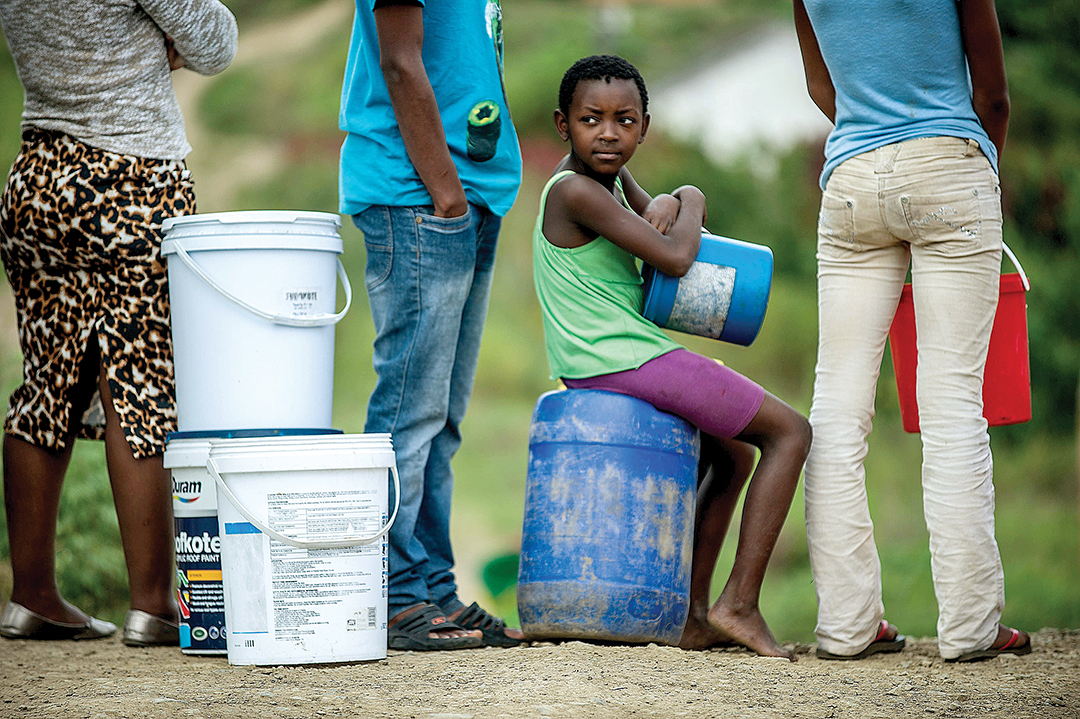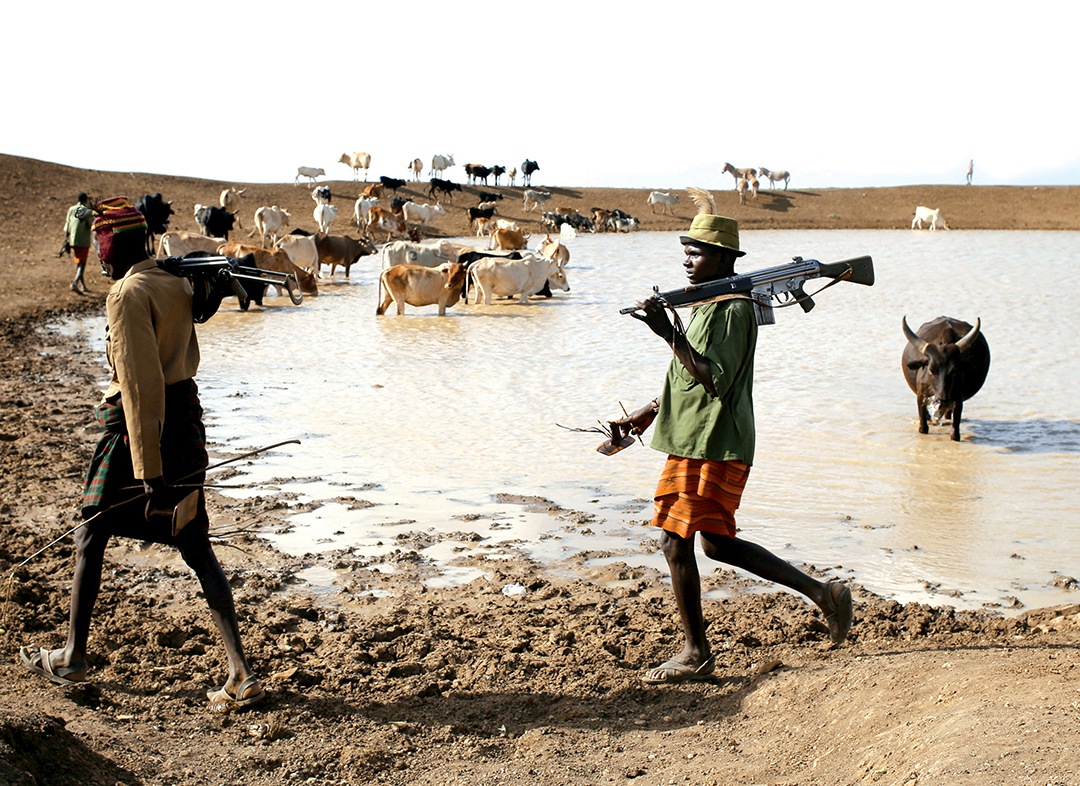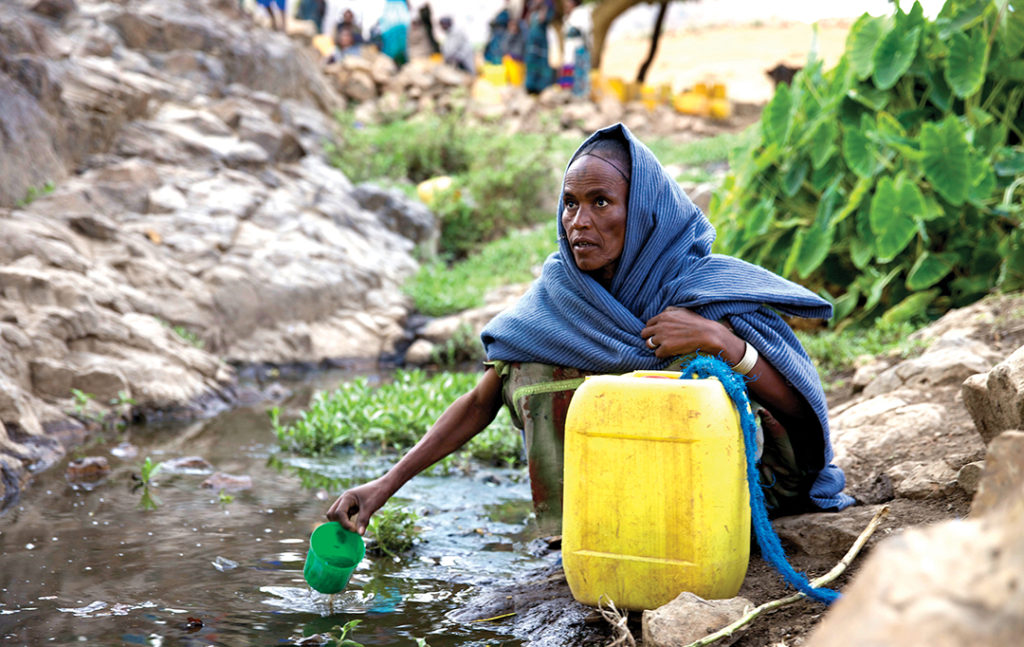Water Flows Through a Full Range of African Human Security Challenges
ADF STAFF
Lake Chad, which sits near the geographic center of Africa, can be seen as a symbol of the continent’s extraordinary water challenges. The lake, whose waters for centuries lapped at the shores of what is now Cameroon, Chad, Niger and Nigeria, is a mere shadow of its former self.
Between 1963 and 2001, the lake’s total area shrank from 25,000 square kilometers to 1,350 square kilometers. Overgrazing, excessive use, changes in climate patterns and unsustainable irrigation projects in surrounding countries combined to cause the decline.
The livelihoods of nearby populations, estimated as high as 30 million across the four countries, are inextricably tied to Lake Chad. With its decline has come a downturn in the fortunes of these residents. For example, farmers and livestock herders increasingly divert the water for their use at the expense of fishermen who depend on catches in the lake, according to the Global Water Partnership.

“As income sources were lost, basin residents were forced to move to inhospitable surrounding environments, disrupting local governance and social institutions, and creating opportunity for illicit networks as well as large concentrations of traumatized and marginalized youth,” wrote Africa expert Devon Knudsen for the website African Arguments. Those conditions make the region ripe for the flourishing of another threat: Boko Haram.
The Lake Chad region alone provides an example of how a host of factors converge around water to breed insecurity: A once-vibrant lake is affected by regional climate changes; people increase their use of the lake’s water to bolster lagging livestock and crops, further draining the resources; concurrent food insecurity and health problems lead to poverty, migration and deforestation; and all of these things make populations more vulnerable to violence and recruitment by a regional extremist organization such as Boko Haram.
THE BURDEN OF ACCESSING WATER
Water problems exist all over the continent, and they manifest themselves in different ways in rural and urban areas. Governance, infrastructure and weather also play large roles in the availability and provision of water.
The stress of obtaining sufficient water can be a huge burden, especially for rural families. For example, a family in Nabitenga, Burkina Faso, uses about 400 liters of water a day during the dry season for bathing, cooking, drinking and taking care of livestock, according to the London-based nongovernmental organization WaterAid.
For many rural residents, obtaining that much water involves family members — almost always women and girls — walking for hours to fetch it from a remote well, lake or river. They carry the water home themselves; a jerry can weighs more than 18 kilograms. In 2010, at least 25 percent of the population in more than a dozen African countries walked more than 30 minutes round trip to get water, according to UN-Water.
To put it in perspective, Lifewater says that people spend 40 billion hours a year gathering water in Sub-Saharan Africa alone. That means that Sub-Saharan Africans, together, spend nearly 4.6 million years gathering water every year.

“Just think what could be achieved with the hours released if the long daily trek to the well or river for water was not needed?” wrote Anna Swaithes, SABMiller’s head of water and food security policy, for World Economic Forum. “Or if communities were freed from the need to move in search of water during dry seasons?”
The costs and effort associated with running infrastructure to far-flung rural areas is obvious, but costs are a concern even in urban areas. In urban slums, infrastructure is typically absent, so residents often must obtain water from community taps. People living in Kenyan slums can expect to pay five to 10 times more for water than people living in high-income areas, according to Africa Water Atlas.
Côte d’Ivoire, a country of 23 million people, has had some success in working with private interests to provide water service to its citizens. In 1987, the government entered an arrangement with the Société des Eaux de Côte d’lvoire (SODECI). The private company produces 209 million cubic meters of water from more than 500 boreholes and 70 treatment stations; provides drinking water to nearly 800,000 customers in more than 700 cities and towns; and provides sanitation service to nearly 400,000 people in Côte d’Ivoire.
The government sets policy, and SODECI manages water services under contract with the government’s Water Directorate. A surtax on water bills subsidizes household connections, and a rising block tariff based on consumption provides a cross-subsidy from large to small consumers, according to the Water Sanitation Program, a World Bank Group entity. Finally, SODECI licenses resellers in informal settlements, which allows it to influence cost and quality in areas where it is not otherwise allowed to operate.
As a result, 93.1 percent of Côte d’Ivoire’s urban population has access to an improved drinking water source, as does 68.8 percent of its rural residents, according to The World Factbook.
CLEAN WATER IMPROVES HEALTH
Despite costs, providing access to clean water can help nations avoid the outbreak and spread of disease. The connection between disease and lack of access to clean water in Africa is clear and reinforced yearly all over the continent during rainy seasons. According to The Water Project, 783 million people do not have access to clean water, and 37 percent of those live in Sub-Saharan Africa. In Nigeria alone, WaterAid estimates that dirty water killed 73,000 people in 2014 — nearly seven times as many people who died in the West African Ebola outbreak.
Prominent water-borne diseases such as cholera and diarrhea kill thousands of people across the continent every year. Guinea-Bissau saw 14,303 cases of diagnosed cholera during the wet season in 2005, and 252 eventually died, according to Africa Water Atlas. The World Health Organization estimates that 0.75 cases of diarrhea occur per person worldwide each year. But Sub-Saharan Africa’s rate is the highest in the world at 1.29 cases per person per year.
Malaria, Guinea worm disease, river blindness and Lassa fever all can be connected to poor water and sanitation resources. Schistosomiasis, which is also known as bilharzia, is spread by freshwater snails and is present across the majority of the continent.
As of 2008, 31 countries in Africa had less than 75 percent of their populations using improved drinking water sources. In two countries the total was less than 40 percent; Ethiopia had 38 percent, and Somalia had 30 percent. In Somalia, one of the primary reasons for the lack of clean water was civil unrest.
WATER OFTEN CENTRAL TO CONFLICT
Water is scarce in many parts of Africa, so it’s no surprise that it would be at the center of conflicts. Clashes typically arise in two contexts: in the competing interests of farmers and herders, and from violent extremist groups that target and damage water sources to control populations and territory. These types of violence pose the most immediate impact to human security and national security forces.
Somalia-based extremist group al-Shabaab has waged what has been called “water terrorism” by cutting off water sources to government-controlled cities, Knudsen wrote for African Arguments.
When droughts and famines strike, groups such as al-Shabaab can step in and provide relief, exploiting communities in the absence of government action. “Some of Al Shabaab’s most effective ‘hearts and minds’ activities have provided water services supporting farmers and pastoralists,” Knudsen wrote. “Al Shabaab has also been a major obstacle in allowing humanitarian aid from reaching those affected most by famine.”
Similar tactics have played out in the Middle East at the hands of ISIS, which is a growing threat in Africa, particularly in Libya. In fact, using water as a weapon dates back at least as far as World War I, when the Belgian town of Nieuwpoort opened the gates of the Yser River and flooded Flanders to halt the advance of the German Army.
ISIS has used similar tactics in Iraq and Syria. As recently as March 2016, Deutsche Welle reported, ISIS controlled six of eight large dams on the Tigris and Euphrates rivers and was attacking another.
“On one hand, IS is damming the river to retain water and dry up certain regions, thereby cutting off the water supply to villages and communities,” Tobias von Lossow, of Berlin’s Institute for International and Security Affairs, told Deutsche Welle. “On the other hand, it has also flooded areas to drive away their inhabitants and to destroy their livelihoods.”

ISIS also has used another water tactic: contamination. In December 2014, ISIS poured crude oil in the water south of Tikrit, Iraq, making it unsafe to drink, von Lossow said.
Water also is at the center of smaller-scale violent clashes all over the continent. In the village of Itunundu in Tanzania’s southern highlands, farmers and herders had long been at odds over water used to irrigate crops and feed animals. “Pawaga division is considered one of the bread basket areas of Tanzania where people grow maize, rice and vegetables in the valleys whereas others keep animals in the highlands,” IPS news agency reported in March 2016. “Despite a clear demarcation of the areas that are controlled by farmers and those controlled by herders, there have been frequent clashes.”
Now, representatives from the groups are finding peace at the negotiating table with the help of the Tanzania Natural Resource Forum, a civil society group. Farmers and pastoralists meet often to talk about solutions to their problems. “Farmers and herders need to know that there are people who benefit from their conflicts and do not wish to see the conflicts resolved,” Godfrey Massay, the group’s land-based investment coordinator, told IPS. He said recurring fights are a symptom of externally driven factors involving bigger agricultural and conservation interests.
“This is the first and the only platform that brings together farmers and pastoralists to discuss issues that affect them openly without fear or favor,” Massay said. Within six months of its start, the number of violent clashes dropped.
Donald Mshauri, Iringa district land officer, told IPS: “This shows that no matter how deep the conflict is, it can be resolved by just talking.”

